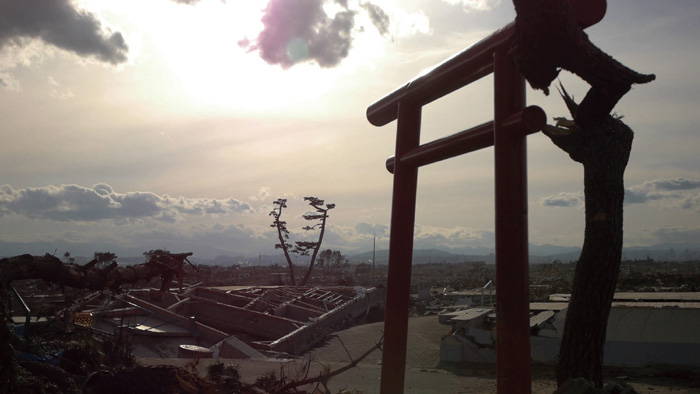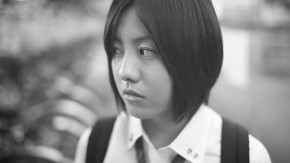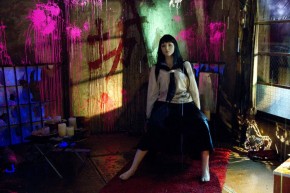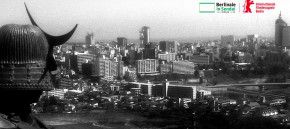By Kerrine Goh
Observations on Japanese Cinema after 3/11

Several months have now passed since the 3/11 disaster receded from view in the international media. Visible or invisible, though, the situation in north-east Japan remains very difficult, as an uncertain process of coming to terms with the disaster has only begun. The region of Tohoku bore the brunt of the catastrophe, but 3/11 has become an event whose scope encompasses the entire nation and, arguably, has deeply affected people throughout the world. Regardless of whether we have been directly affected, the 3/11 disaster and ongoing nuclear crisis press us anew to reflect more deeply on the conditions of our existence. It prompts us to ask: what does disaster mean to us?
In the wake of 3/11, many people involved with the culture and business of film have been wondering about its impact on the Japanese cinema. In particular, how have audiences and filmmakers responded to the disaster? How, and in what ways has 3/11 affected the production and consumption of films in Japan? Which sectors of the industry (production, distribution, festivals) and which forms of production (mainstream, independent, documentary) have been affected? Above all, what role can cinema play in understanding the disaster and recovering from it? Some of these questions may be too broad to produce satisfying responses as yet, but they can perhaps still help us as we try to understand this disaster, or others, both past and future. While is it still early to speak about the Japanese cinema and 3/11, I would like to hazard a few observations.
Immediately following 3/11, the Japanese media debated "self-restraint" [jishuku] and "refraining from consumption" [shōhi no jishuku] as many people voluntarily withdrew from activities that involved entertainment or leisure. Yet, cinema is clearly more than diversion from the routines of everyday life, and has a significant role to play in understanding and coming to terms with the disaster. Recognizing this early on, film publicist Eiko Mizuno Gray created Niji-iro Cinema, a traveling theater that provides free screenings in the areas ravaged by the tsunami. From its first projection in April, this itinerant cinema has cheered audiences with popular films, anime, and hot meals. In a little over six months, Niji-iro has hosted over 100 screenings at 15 different locations in Tohoku, and gathered support from local governments, NPOs, domestic and international distributors in Japan and the United States.
For the commercial film industry, the first effects of the disaster were registered in multiplex theater programming. Immediately following the tsunami, distributors halted the exhibition of disaster-themed dramas such as Clint Eastwood's Hereafter, while delaying the release of Xiaogang Feng's blockbuster Aftershock, Higuchi and Inudō's Nobō no shiro, and The Rite, starring Anthony Hopkins. In mid-April, director Yamada Yoji postponed the shooting of his remake/homage to Ozu's 1953 Tokyo Story (to be entitled Tokyo Family), stating: "before and after March 11, both Tokyo, the attitudes, and hearts of the Japanese may have changed." Yamada decided to wait, review his screenplay at the end of 2011, and begin filming in March 2012. As the mood of jishuku abated throughout Japan, box office numbers quickly recovered to more or less average levels. The much-feared summer electricity cuts were avoided, but the industry remained cautious. Distributors were of a mind that only upbeat films or comedies could be successful (e.g., Hitoshi One's Moteki or Koki Mitani's A Ghost of a Chance).
 Looking at industry figures only gives us one angle on the situation of Japanese film, but they can be a useful point of reference. From around 2005-2006, the Japanese cinema enjoyed a minor boom. For the first time in two decades, the number of Japanese films released domestically exceeded that of foreign productions. In 2008, 418 Japanese productions were released, as opposed to 388 imported films. Young people began taking a greater interest in cinema, and the overall number of films reached a new peak of over 800 released each year. At the same time, these numbers are somewhat deceptive insofar as they include many low-budget domestic productions that have either a very small-scale theatrical release or belong to "V-Cinema" (direct-to-video releases). The majority of these are not commercially successful. In 2010, for example, just 29 films out of over 400 domestic releases were considered "hits", drawing ¥ 1 billion or more. By comparison, thus far in 2011, only 22 films have reached this mark. In the current parlance, it might be said that a post-bubble dynamic still governs film production. Industry figures for 2011 are not yet available, but the advance word is that total revenue is expected to be roughly 20 percent less than last year. Among the large production companies, only Toho and Studio Ghibli seem to be doing well. Thus far, the consensus among industry observers has been that rather than the impact of 3/11 proper, it is an underlying structural weakness in the industry — and especially in Japanese film culture — that gives cause for the greatest concern.
Looking at industry figures only gives us one angle on the situation of Japanese film, but they can be a useful point of reference. From around 2005-2006, the Japanese cinema enjoyed a minor boom. For the first time in two decades, the number of Japanese films released domestically exceeded that of foreign productions. In 2008, 418 Japanese productions were released, as opposed to 388 imported films. Young people began taking a greater interest in cinema, and the overall number of films reached a new peak of over 800 released each year. At the same time, these numbers are somewhat deceptive insofar as they include many low-budget domestic productions that have either a very small-scale theatrical release or belong to "V-Cinema" (direct-to-video releases). The majority of these are not commercially successful. In 2010, for example, just 29 films out of over 400 domestic releases were considered "hits", drawing ¥ 1 billion or more. By comparison, thus far in 2011, only 22 films have reached this mark. In the current parlance, it might be said that a post-bubble dynamic still governs film production. Industry figures for 2011 are not yet available, but the advance word is that total revenue is expected to be roughly 20 percent less than last year. Among the large production companies, only Toho and Studio Ghibli seem to be doing well. Thus far, the consensus among industry observers has been that rather than the impact of 3/11 proper, it is an underlying structural weakness in the industry — and especially in Japanese film culture — that gives cause for the greatest concern.For independent productions, financial constraints have been particularly acute. In response to the disaster, a number of projects were suspended, and those that continued often had to make do with drastically reduced budgets. Following the "Lehman shock" of 2008, it had already become increasingly difficult to fund indie films. Previously, a typical low-end budget had been around USD 1 M, but a number of post-3/11 projects have been constrained to budgets of one-half million (about ¥ 40 million) or even USD 25,000. As industry people say, many projects have passed "from low-budget to no-budget." Directors like Sono Shion (Love Exposure, Cold Fish, and Guilty of Romance) and Kobayashi Keiichi (About the Pink Sky) have managed to create very compelling films on modest budgets, while independents Tetsuaki Matsue and Yu Irie have had mixed results. Despite these financial constraints, Sono's films have found success by fitting into more recognizable genres.
[caption id="attachment_6190" align="alignright" width="290" caption="A scene from Sono's "Guilty of Romance""]
 [/caption]
[/caption]In relation to 3/11, independent films have been among the first dramatic works to engage with the disaster, by weaving the very real events in Tohoku into their fictional narratives. Ryūichi Hiroki's River addresses the disaster in this manner, exploring the emotional loss through the character of Hikari, a young woman touched by the Akihabara massacre of 2008, and Yuji, a runaway living on the streets of the Electric Town who loses his parents in 3/11. The difficulty in this film emerges as it attempts to connect these two overwhelmingly tragic events. Oddly, the pathos of the principal characters never becomes credible, and the inclusion of 3/11 into the Akihabara story begins to feel like relevance mongering. A more measured approach to showing post-3/11 Japan can be seen in Matsue Tetsuaki's Tokyo Drifter. Here, the effects of the disaster are depicted as being indirect, as the new darkness of the city under the policy of setsuden (saving electricity — an expression of jishuku in the medium of urban space) and the auto-focus DIY aesthetics of the youtube generation enter Matsue's film together.
Perhaps we can say that where the big-budget dramatic films have thus far tended to register 3/11 by deferring, restricting, or distancing what is deemed appropriate to show, the low-budget films have greater immediacy and flexibility, while their production values have become more constrained. (To be fair, the position of the big-budget cinema vis-à-vis 3/11 has been imposed by distributors fearful of appearing insensitive, rather than by directors who wish to portray its human dimensions.) The difficulty facing the newest low-budget films is simply that while they have generated buzz in Japan and while they have been screened at international festivals, their weak visual qualities and ambiguous relationship to film craft will likely preclude foreign theatrical distribution. It has been argued that these films are, in effect, also interrogating our sense of what "craft" means (or should mean) for low-budget production, but however valuable this inquiry may be, I wonder how much resonance it can create in general audiences, especially those outside of Japan.
[caption id="attachment_6189" align="alignleft" width="290" caption="A scene from Matsue's "Tokyo Drifter""]
 [/caption]
[/caption]To date, some of the most thoughtful and critical responses to 3/11 have been independent documentaries. In October, twenty-nine different films were screened at the Yamagata International Documentary Film Festival (YDIFF), in addition to a symposium that brought together filmmakers, activists, and the inhabitants of Tohoku. Among the films in this program, Omiya Koichi's The Sketch of Mujō and Mori Tatsuya's 311 were widely noted as, respectively, one of the most carefully composed, and one of the most controversial attempts to make sense of the disaster. Another highly significant work is Fujiwara Toshifumi's No Man's Zone, which screened at FILMeX in November. All three of these films show a ground-level view of post-3/11 life in Tohoku, including lengthy and profoundly unsettling views of the devastation, interviews, and heartbreaking testimony from survivors. The film scholar Abé Mark Nornes has noted how these films employ similar formal strategies to depict the incomprehensible magnitude of the disaster: "Half a century back, just west of here, crews of filmmakers faced the same dilemma — not to mention a similar landscape — in the ruins of Hiroshima and Nagasaki. Back then, their strategy was the pan. They scanned the disaster from a fixed point. The first films about the atomic bombings are filled with such shots. Today, they have replaced the pan with the truck. Or more specifically, the car or bike. The tsunami films are chock full of lengthy shots photographed from moving vehicles."
Despite these formal resemblances, the films of Omiya, Mori, and Fujiwara each press the audience in distinct ways, to engage with deeper questions about our relationship to this disaster, and as spectators of images of disaster. At the level of both story-telling and reportage, they differ markedly in their approach to the survivors and their use of a directorial voice, raging from Omiya's detached style of extreme discretion to Mori's aggressive interventionism. Where Omiya refuses to appear or grant himself a voice in his film, letting the people he meets speak for themselves, Fujiwara not only enters the interviews, but also avails himself of both commentary on the situation, and meta-commentary on our relationship to the documentary image. As a point of departure, Omiya considers the medieval concept of mujō — the impermanence of all things — as a way of understanding our relationship with disaster. Yet, he also foregrounds his discomfort that we might accept something like mujō as an optic on the world, and that perhaps instead we have an equal or greater need to capture and record the fear evoked by disaster, to rescue it from the oblivion of time.
The conflicted nature of the documentary impulse erupts more violently in Mori's 311. In several sequences, the director's intrusive approach clashes with survivors who expressly do not wish to be filmed, and finally things get ugly. For a number of critics, 311 raised questions about "disaster tourism", though in public discussions director Mori and his crew have openly wondered about documentary film as a form of violence, and the problem of filming the disaster as a way of mediating or expiating a sense of survivor's guilt. How can the need to document and remember 3/11 be balanced with sensitivity to the needs of its survivors? If Mori's 311 goes the furthest in pressing us to consider ethical questions of filmmaking, Fujiwara's No Man's Zone could be said to offer the most sustained reflection on our relationship with the documentary image. In this regard, the relations of power circulated through mass-mediated images may seen as an invisible adversary to these documentaries. Fujiwara explores the problem that today, perhaps, we have become addicted to mass images of destruction, and yet without images of this disaster, what memory could we preserve of it? Would an absence of images be a greater disaster? In different ways, then, each of these films prompts us to think about the ethics and significance of image-making.
It is certainly too early to measure the effects of 3/11 on the Japanese cinema, but it is clear that film can provide a means and a space for us to begin to heal, and to critically engage with more difficult questions surrounding our relationship with disaster.
About the Author
M. Downing Roberts is a research fellow at the University of Tokyo Center for Philosophy (UTCP). He is currently working on a study of the postwar Japanese cinema during the high-growth period.
Similar content
posted on
posted on
posted on
posted on
posted on
posted on



